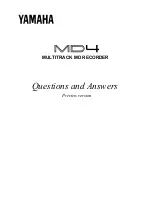
8-2
IM DR231-01E
8.1 Setting Alarms and Relays (including internal switches)
Selecting the type of alarm
• Select an alarm type for each alarm number from among the following:
• OFF (default set): No alarm is set.
• H: Upper-limit alarm. An alarm occurs when the measured value exceeds the upper-limit
alarm setpoint.
• L: Lower-limit alarm. An alarm occurs when the measured value exceeds the lower-limit
alarm setpoint.
• RH: Rate-of-change upper-limit alarm. An alarm occurs when the measured value changes
in the increasing direction within a certain time (rate-of-change alarm interval) and exceeds
the upper-limit alarm setpoint.
• RL: Rate-of-change lower-limit alarm. An alarm occurs when the measured value changes
in the decreasing direction within a certain time (rate-of-change alarm interval) and exceeds
the lower-limit alarm setpoint.
• dH: An alarm occurs when the difference between two channels exceeds the alarm setpoint.
This only applies to a channel for which interchannel differential computation is selected,
and can be set as a type of alarm.
• dL: An alarm occurs when the difference between two channels exceeds the lower-limit
alarm setpoint. This only applies to a channel for which interchannel differential
computation is selected, and can be set as a type of alarm.
• For details on the rate-of-change alarm interval setting or other basic alarm settings, see Section
10.3, “Select Alarm Interval/Hysteresis/Hold A/D Converter Integration timer/Filter” on page
10-8.
• For details on interchannel differential computation, see Section 5.1, “Setting the Type of Input
and Recording Span” on page 5-3.
• Only H (upper-limit alarm) and L (lower-limit alarm) are available for computation channels.
Setting alarm values
Set one alarm value for each alarm number within the following range, depending on the type of
input. The default value is 0 (zero).
• H and L
• VOLT, TC, RTD, DI, and DELTA: Within the measuring range in the related channel. DI
can be set to either 0 or 1.
• SCALE: Within a linear scaling value.
• Computation channel: Within the range specified by the computation function
• RH and RL
• VOLT, TC, RTD, DI, and DELTA: Within 1 to [maximum measuring range minus
minimum measuring range] in the related channel. For example, set 30000 (without using a
decimal point) if the maximum value exceeds 30000. DI can be set to only 1.
• SCALE: Set 1 to 30000 without using a decimal point.
• dH and dL
• When the standard channel uses VOLT: Within the measuring range.
• When the standard channel uses other than VOLT: [maximum measuring range minus
minimum measuring range] to - [maximum measuring range minus minimum measuring
range]
• For the type of input, see Section 5.1, “Setting the Type of Input and Recording Span” on page
5-3.
Note
When setting alarm values in continuous channels, use the decimal point as follows:
The decimal point of an alarm value when the continuous channels have different measuring ranges
should be in the position determined by the individual measuring range. If the decimal point is outside
the measuring range, an error occurs. For example, if channels with measuring ranges 20 mV and 2 V,
and a type T thermocouple channel, are all set to an alarm value of 10000, then the alarm values in the
respective channels are as follows:
10.000 mV in the 20 mV measuring range channel
1.0000 V in 2 V measuring range channel
1000.0
°
C in the type T thermocouple channel
A type T thermocouple has a measuring range from -200.0 to 400.0
°
C, so an error results. For details on
the decimal point positions in individual measuring ranges, see Chapter 14, “Specifications.”
Summary of Contents for DR231
Page 12: ...10 IM DR231 01E...
















































